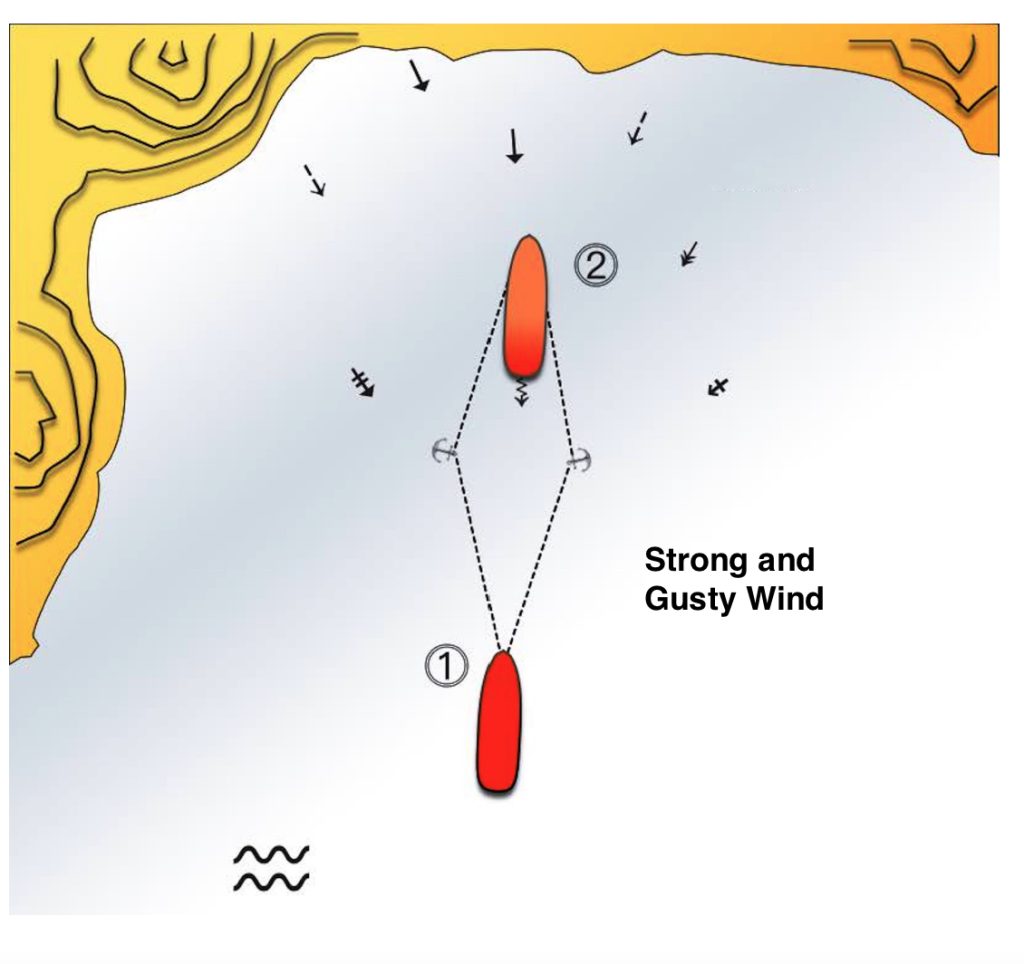Keep the Position or Proceed Up and Down? Copy
Weighing anchors in the strong wind and high seas is challenging.
With a strong current or wind, the chain is in hard stretching. The engine can be helpful to lighten the load on the windlass. Putting the engine ahead for short periods loosens the tension on the windlass and allows the latter not to force during recovery.
In deep waters, where we approach the physical limit of the windlass, it can be helpful to heave up the part of the cable that does not create stress on the windlass, stop heaving, and drag the anchor towards shallower waters where we can haul up the entire chain. This system can also be used in shallow water when the windlass has failed and does not express its full power.
When the anchor is long-run, it will be helpful from that moment on to tune the engine ahead dead slow to overcome external forces and gain momentum, thus helping to dispatch the anchor.
But what can we do if we want to keep the anchorage and delay weighing the anchor as much as possible? Whit strong shore winds and ‘good holding’ seabed. It may be convenient to stay at anchor.
The sudden efforts due to the wriggling of the ship due to the instability of gusty wind combined with irregular wave motion can create problems with the chain. Fetch can be very tricky.
The brake must hold 45% of the breaking strength of the chain (80% if there is no chain stopper). The windlass brake is essential to control the pay-out of the chain.
The first thing to do as the wind grows is to slack more cable to make the mooring more elastic and increase the effect of withholding. When you fear the breaking of the chain, you have to drop the second anchor.
The V-configuration guarantees a more excellent hold, but only if the two chains are regulated equally. Otherwise, there is a risk of breaking them both in succession.
Finally, to further loosen the stretching on the anchors, resort to the use of the engine, but a lot of caution is needed to counteract such variable elements like the gusty wind and the rough sea.
The use of intermittent engine requires eye contact, which an Officer can only make at the bow by checking the actual chain’s movement to allow the Master to vary the thrust force of the propeller.
However, if even this method fails to guarantee the correct work of the chains, and the sudden flickers and yaws become unmanageable and risky, you can eliminate the violent forces keeping the chains in slight tension.
It Is Always a Sudden Effort That Breaks the Chain
So, it is possible to proceed slowly towards the anchors and, if space permits, overtake them until the chains come into tension.
Keeping the ship slow-moving ahead against the wind allows you to prevent dynamic peaks on the same and can delay or even avoid the moment when you have to heave up and move away from the shelter of the coast, leaving the harbour.
By this method, the chains will undergo constant strain avoiding strong shocks and, above all, the ship will be under command and always keep the bow to the wind by acting on the rudder for positioning towards the most violent gusts.
In the image, note (in red) the influence of the wind on the hull before & after:

Before leaving the harbour for the open sea, it is necessary that the anchors are correctly rigged and safely secured and stowed in the hawsepipes.
Excessive slack may cause hammering of anchors on the ship’s hull. The hammering may lead to the loss of the anchor by breaking the D-shackle securing pin. D-shackle is a delicate connection between the chain and the anchor ring, and its detach is a common reason for the loss of anchors.
The brakes have to be applied, the chain stopper engaged, the lashing tensioner cables secured, and the windlass clutch disconnected. It is all done to prevent damages.
Emergency Release of the Anchor from the Bitter End
Constantly monitor the weather forecast and leave the anchorage in time if heavy weather approaches.
If, due to unforeseen circumstances, you don’t have time to haul up the anchors, or you don’t have the option to do so, as in the case of damage to the windlass, and you must escape from the anchorage being this is the only way of salvation. Then you will have to ‘let go to loose’ the anchors and part of the chains.
In this case, you could tie an ‘anchor buoy’ to mark the exact spot for later recovery once the storm has passed.
Once you are in the open sea, the ship will have to go Up & Down. Following the most straightforward course to move away from the coast and then go back with the opposite route.
Therefore, we will have to do that until the weather calms down, permitting us to go back anchoring or recover the anchor(s).
